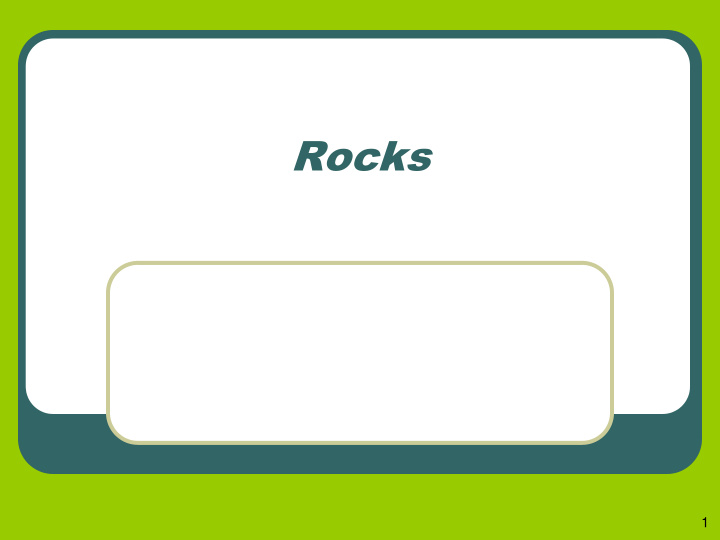



Rocks 1
Rocks in Relation to Minerals Many kinds of rocks are composed of minerals • Granite ; mica , feldspar and quartz Monomineralic; rocks that are composed of only one mineral . • Limestone – Calcite Polymineralic; rocks that are composed of two or more minerals • Granite There are almost 3,000 types of minerals • only 8 of these minerals make up 90% of the rocks on Earth’s crust. 2
Common Rock Forming Minerals Quartz 12% Potassium Feldspar 12% Clays 4.6% Plagioclase Feldspar 38% 3
Classification of Rocks • Petrology: the branch of science that studies rocks. Rocks are classified based on their method of formation (origin). 3 Rock Groups • Sedimentary • Igneous • Metamorphic 4
Sedimentary Rocks Rocks that usually form in horizontal layers ; from the accumulation of sediments , organic matter, or chemical precipitates • Underwater in lakes, seas or oceans Time Pressure Pressure Silt Silt Silt Sand Sandstone Clay Shale Silt Siltstone Clay Shale Pressure/weight Layers of sediment Sediment is compacted squeezes lower deposit and accumulate and cemented into rock layers 5
Types of Sedimentary Rocks Clastic : form from rock particles and sediment that are pressed and cemented together. • Compaction: pressed by weight of overlying rock • Cementation: glued by natural cements in water (calcite) After Deposition Compaction Cementation 6
Clastic Rocks 7
Types of Sedimentary Rock Chemical : form from minerals dissolved in water; which settle-out/ precipitate . • Dissolved minerals are left behind when water evaporates 8
Types of Sedimentary Rock Organic : form from the accumulation of plant/animal matter that undergoes a transformation into rock . 9
Formation of Coal 10
Sediment Sedimentary ary Characteristics They are composed of rock fragments or organic particles . Can contain a wide range of particle/ sediment sizes . Some have a uniform sediment size ; due to sorting during deposition 11
Clastic Rocks 12
Important Characteristics Some rocks are organic- they form from plant and animal remains (fossils) Usually form in horizontal layers called strata or beds 13
Igneous Rocks Form from the cooling and solidification or crystallization of molten lava and magma . • When molten lava or magma cools and solidifies the crystals of different minerals form a rock. • The rock contains a crystalline structure of inter-grown crystals of different sizes , shapes , and composition 14
Types of Igneous Rocks Extrusive /Volcanic: • Forms from the fast cooling of lava on or near Earth’s surface . • Fast cooling does NOT allow time for crystals to grow. • Rocks have small to no crystals ; smooth/ fine texture Intrusive /Plutonic: • Forms from the slow cooling of magma within the Earth. • Slow cooling allows time for large crystals to grow • Rocks have large crystals; coarse /rough texture 15
Environment of Formation Environment of Formation Extrusive (Volcanic) Intrusive (Plutonic) Rate of Very Fast Fast Slow cooling Grain Size Non-crystalline Less than 1mm or larger 1mm Texture Glassy Fine Coarse Examples Obsidian Basalt Granite Rhyolite Gabbro 16
Crystal Size vs. Cooling Cooling Rate Rate Location in Earth’s crust effects the cooling rate Crystal Size No Crystals Very Fast Cooling Small Crystals Fast Cooling Large Crystals Slow Cooling Rate of Cooling 17
Igneous Rock Identification 18
Metamorphic Rocks Rocks that form from pre-existing rocks (sed., ign., meta .) that have been changed . • Molecules can rearrange and form new rocks due to contact with extreme heat (magma), or extreme pressure (orogeny) • Often found in mountainous regions where the deeper bedrock is exposed due to weathering and Pressure erosion Metamorphic Rock Heat 19
Types of Metamorphism Conditions that cause rocks to undergo metamorphism • Heat • Pressure • Chemical Activity Contact Metamorphism • Rocks around a magma/lava can be metamorphosed through direct contact with the magma or lava Regional Metamorphism • Rocks buried deep within the crust can re-crystallize due to extreme pressure applied during mountain building events 20
Results of Metamorphism Recrystallization - Environments within the crust with high temperatures and high pressure; cause rocks to change by recrystallization. • New mineral crystals can grow from the sediment in sedimentary rock, and from the “old” crystals in an igneous rock. • No true melting; called partial melt (plastic) • Increased Density • Chemical Change/ New Minerals • Foliated/Non-foliated 21
Types of Metamorphic Rock (Texture Texture) Non-Foliated /Unfoliated • Rock does not have mineral crystals arranged in layers; do not break in layers/sheets • Marble, Quartzite, Anthracite Coal Foliated • Rock has mineral crystals arranged in layers or parallel “ bands .” • Banding: Gneiss & • Mineral Alignment : Schist, Slate 22
Metamorphic Changes Banding • Mineral crystals join and arrange in layers . • Increase in heat and pressure usually produces thicker bands of alternating crystals • Distorted Structure • The folding of the mineral bands due to extreme pressure exerted on the rock . Mineral Alignment • Minerals join; but do not form visible layers . • Creates a shine or veneer on the rock 23
Metamorphic Rocks T Metamorphic Rock e Original Rock Type xt ur e Shale Sedimentary F Slate o li Slate Metamorphic a Schist t e Granite Igneous Gneiss d U Limestone Sedimentary Marble n - f Sandstone Sedimentary Quartzite o li a Bituminous Sedimentary Anthracite Coal t e Coal d 24
Rock Relationships The Rock Cycle • Any rock can become any other rock as shown by the processes in the rock cycle. 25
Rocks Igneous Sedimentary Metamorphic Conglomerate Granite Intrusive Sandstone Clastic Slate Gabbro Plutonic Siltstone Sediment Foliated Schist Diorite Shale Gneiss Bituminous Marble Organic Coal Quartzite Unfoliated Bioclastice Limestone Anthracite Chalk Coal Pumice Extrusive Obsidian Limestone volcanic Basalt Rock Salt Rhyoltie Crystalline Rock Chemical Gypsum 26
Famous Rocks Stonehenge Grand Canyon; layers of Sedimentary rocks Pyramids; Limestone • White House; Sandstone 27
Recommend
More recommend